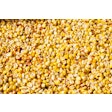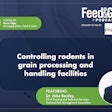
In Part One, featured in our January issue, Feed & Grain looked back at the 2007 corn crop and its effect on wheat and grain sorghum acreage use and production last year, and the prospects for trade in 2008. In Part Two, we take a similar look at barley, soybeans and cottonseed supplies.
As pointed out in the first installment of this two-part series, the 2007 corn crop — all 90+ million acres of it — literally and figuratively, cut an extremely wide swath throughout the agricultural landscape. And its effects will continue to be felt this year.
“Last year was quite a beast in many respects,” says Steve Edwardson, executive administrator, North Dakota Barley Council. “Between acreage swapping, the burgeoning biofuels sector, a wildly volatile marketplace and simply getting a crop produced, there was nothing routine or ordinary about the 2007 growing season.”
No truer words.
With the marketplace prepping for a monster crop and the discussion turning to feedstock shortages, price volatility arrived early and stayed late last year. Like a houseguests who have overstayed their welcome, the volatility is still around today and showing no signs of leaving anytime soon.
“The marketplace this year is shaping up to be as unpredictable as last year,” says John Hoffman, president, American Soybean Assn. and a Waterloo, IA soybean producer. “Nevertheless, as producers and marketers, we need to listen to what the market tells us. So far this year, it’s telling us that it needs more protein and more soybeans.”
Nearly a straight swap
The planted corn acreage jumped nearly 12 million acres last year and people wondered from where that additional acreage would come. Well, on the surface, it would appear soybeans bore much of the brunt as acreage totals dipped a bit more than 11 million acres from 2006 totals (63.7 million in 2007 vs. 75.5 million in 2006).
However, there’s another story lurking behind these acreage numbers that delivered a domino effect of sorts in a variety of crops.
As export partner nations began worrying about tightening feedstock supplies coming out of the United States, the rush for feed grains intensified across the board. Obviously, customers were anxious about corn supplies but demand for soybeans, wheat, barley, grain sorghum and other commodities felt the squeeze too.
“Only a few years ago barley was in a minor lull as exports were concerned but as global demand increased and global stocks decreased we saw a rapid rise in activity,” says Edwardson. “It’s a rare occurrence when you can flip a marketplace around in a couple of year’s time. But we saw it occur in less than 18 months and really, much of it in 9 months.”
View the Barley Market Prices in Bottineau, North Dakota chart in PDF format.
The dramatic turnaround in barley was a prime example of the “perfect storm” phenomenon seen in many grain markets last year. In 2005-2006, barley acres were trending down to flat in many areas, in favor of corn and soybeans. With better prices patterns for these other crops and a pretty healthy carryover of malt and feed barley stocks, the marketplace was somewhat stagnant.
Like a thunderhead that forms in a Northern Plains summer sky, crop failures in Australia, a buying frenzy by Pacific Rim customers, numerous ethanol plant openings pushing corn prices, all conspired to generate a lot of heat and humidity as 2007 approached.
Now, growers could justify boosting their barley plantings at the expense of soybeans, cereal grains and in some cases, corn acres to capitalize on the barley boom. And what a boom market it was.
“Feed barley prices in July of 2006 were about $1.40/bushel,” Edwardson recalls, “A year later they were hovering between the $3.00 and $4.00 range, and by October we were seeing some markets topping $6.00 per bushel.
“To top it all off, this occurred in a market where we saw a near 20% increase in harvested acreage over the previous year. It was truly an amazing year,” he admits.
The interesting part of this “perfect storm” phenomenon is what was happening in the barley market was replicating itself in the wheat, grain sorghum and, of course, corn markets.
From an acreage standpoint, the soy, and dry edible bean markets, along with cotton saw the most significant acreage declines, but acreage and yield declines certainly didn’t dampen the market’s enthusiasm for beans and cottonseed for feed.
2008: Another wild ride?
For producers, market analysts and customers alike, any thoughts of market stability being ushered in with the New Year, were quickly brushed aside. Grain prices continued to show impressive gains fueled by big orders early in the marketing cycle.
“The overseas customers are making adjustments to their marketing plans so they won’t be caught short, and they’re being quite aggressive in their pursuit of U.S. soybeans,” says Brent Babb, director, Program Development and Communications, U.S. Soybean Export Council. “We had a large carryover supply heading into 2007. That won’t be the case for this year and will certainly be lower yet heading into 2009.”
Additionally, global demand for feed stock grains will remain high because of our nation’s ability to provide the marketplace with a reliable supply of high quality product. So there’s really no reason to sense any weakening in market position for 2008.
As John Hoffman points out, market turbulence and acreage shifts aren’t the exclusive property of the United States.
“South American producers are expanding their available acreage to accommodate demand for biofuels feedstocks just like we are,” Hoffman notes. “So they face many of the same challenges with meeting demands for a growing domestic feed industry and satisfying the needs of their trade partners.
“Because our ag economies are mutually dependent upon demand for our products, when we see an opportunity worth seizing, you can bet they do too. They have the ability to move quickly on those opportunities as well,” Hoffman says.
Equally as unsettled is the cottonseed market as large shifts in acreage — particularly in the Mid-South Delta producing region — have shrunk the supply of seed available for feed by nearly a half-million tons per year since 2005 to a projected level of 3.3 million tons in 2008. Seed available for the crush (oil production) is also lower over the same period.
View the Cottonseed Supply/Demand chart in PDF format.
“Ours is a story of simple supply and demand,” says Tom Wedegaertner, director, cottonseed research & marketing, Cotton Incorporated. “The demand for corn and soybeans is being met by a supply of acreage that once grew cotton.
“Analysts agree that the trend will continue in 2008 as we can expect acreage to dip from 10.8 million acres last year to estimates ranging from 9.5 to 9.8 million acres for this year.”
Despite an eroding acreage base and lint prices which hover around the $0.70/lb. mark, Wedegaertner reports of great optimism in the industry’s ranks. Optimism fueled mainly by record prices for cottonseed as feed and seed oil.
“Cottonseed prices have strengthened considerably since last summer, even reaching in some instances more than $380/ton in the dairy regions of Washington,” he says. “Add to that the growing crush values of cottonseed oil which in some markets has eclipsed the price received for lint, and producers are capturing more value out of their cottonseed than ever before.”
While dairy producers are certainly less than thrilled by the skyrocketing costs for cottonseed once again, the market has set the price and it looks as though it has the potential to move even further.
“I used to think that the $200/ton mark was the ‘magic number’ for price elasticity in this market,” says Wedegaertner. “Then we started seeing that number move to $250, $275 and now much more than $300. I’m wondering now if soon we’ll see a number beginning with a 4 pretty soon.
“Cottonseed has a place in the dairy producer’s ration because of its proven performance, but it’s like anything else the end users will pay more than they have in the past whether it’s cottonseed, corn, soy meal or other sources,” he says.
Challenges Remain Despite Boom
So with record prices and global demand running at a fevered pitch, one would assume the boom times are pretty good for the U.S. ag sector. The optimism is somewhat tempered by sky-high production costs and transportation challenges.
“Production costs could neutralize profits to some degree as fertilizer, fuel and other inputs have increased dramatically,” Babb notes. “Because of the higher risk growers need larger operating loans,. In some cases in the Midwest, lenders have increased operating loans by an average of 20% to cover input costs.”
Babb also explains that this increase in production costs naturally result in higher prices passed through to the end user, which, often requires coaching for trade partners to understand the production/price relationship.
“We counsel trade partners that rising costs of production do result in higher prices for them, but this provides an excellent opportunity to explore options and fine-tune their purchasing planning,” Babb says. “Container shipping is an example of an attractive alternative for timely delivery of our products.”
For Edwardson and Hoffman, they see transportation costs and logistics issues as major challenges for their respective industries in 2008.
“Transportation problems can be a real profit drag because all the unit trains and railcars are tied up by big shippers moving corn,” Edwardson says. “With a potential increase in feed barley acres upwards of 30% for this year, getting that crop to market in a timely manner presents some challenges.”
“Movement of beans through the pipeline will be critical to capitalizing on market opportunities,” Hoffman notes. “Reasonable rail rates are important and we need to be more efficient at getting grain from the farm gate to the ports because every day we’re late, results in costly delays at the ports.”
What does all this mean for elevator managers and grain marketers? It means that efficient, reliable customer service will become more important than ever, as pressures increase to move more grain to more destinations, more quickly and economically.
“The grower now has more control over their crop’s fate than ever before and their choice of wherethey sell that crop is wide open,” says Edwardson. “Those managers who demonstrate an ability to nimbly maneuver through the marketplace and get the crop quickly into the pipeline will win the day in 2008.”


















